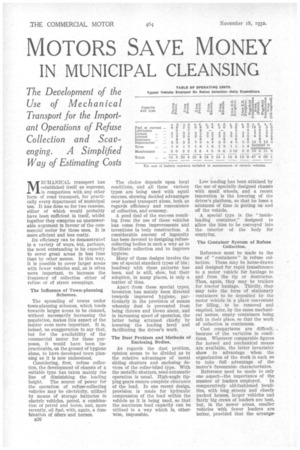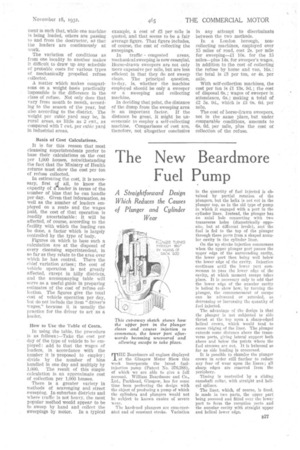MOTORS SAVE MONEY
Page 52

Page 53

If you've noticed an error in this article please click here to report it so we can fix it.
IN MUNICIPAL CLEANSING
The Development of the Use of Mechanical Transport for the Important Operations of Refuse Collection and Scavenging. A Simplified Way of Estimating Costs
MECHANICAL transport has established itself as supreme, in comparison with any other form of road transport, for practically every department of municipal use: It has done so for two reasons, either of which would probably have been sufficient in itself, whilst together they comprise an unanswerable argument in favour of the commercial motor for these uses. It is more efficient and less costly.
Its efficiency can be demonstrated in a variety of ways, but, perhaps, the most outstanding is its capacity to cover great areas in less time than by other means. In this way, it is possible to cover larger areas with fewer vehicles and, as is often more important, to increase the frequency of collection either of refuse or of street sweepings.
The Influence of Town-planning Schemes.
The spreading of towns under town-planning schemes, which tends towards larger areas to be cleaned, without necessarily increasing the population, makes this aspect of the matter even more important. It is, indeed, no exaggeration to say that, but for the availability of the commercial motor for these purposes, it would have been impracticable, on the ground of hygiene alone, to have developed town planning as it is now understood.
Considering, first, refuse collection, the development of chassis of a suitable type has taken mainly the line of diminishing the loading height. The source of power for the operation of refuse-collecting vehicles may be electricity, utilized by means of storage batteries in electric vehicles, petrol, a combination of petrol and horse, and, more recently, oil fuel, with, again, a Combination of oilers and horses.
B26 The choice depends upon local conditions, and all these various types are being used with equal success, showing decided advantages over horsed transport alone, both as regards efficiency and convenience of collection, and economy.
A good deal of the success resulting from the use of these vehicles has come from improvements and inventions in body construction. A considerable amount of ingenuity has been devoted to designing refusecollecting bodies in such a way as to facilitate collection and to improve hygiene.
Many of these designs involve the use of special standard types of bin; headway with these patterns has been, and is still, slow, but their adoption, in many places, is only a matter of time.
Apart from these special types, invention has mainly been directed towards improved hygiene, particularly in the provision of means whereby dust is prevented from being thrown and blown about, and in increasing speed of operation, the latter being attained chiefly by lowering the loading level and facilitating the driver's work.
The Dust Problem and Methods of Enclosing Bodies.
As regards the dust problem, opinion seems to be divided as to the relative advantages of metal sliding shutters and enclosing devices of the roller-blind type. With the metallic shutters, semi-automatic operation is usual. High-angle tipping gears ensure complete clearance of the load. In one recent design, provision is made for hydraulic compression of the load within the vehicle as it is being used, so that the maximum load capacity can be utilized in a way which is, otherwise, impossible.
Low loading has been attained by the use of specially designed chassis with small wheels, and a recent innovation is the lowering of the driver's platform, so that he loses a minimum of time in getting on and off the vehicle.
A special type is the "insideloading container," designed to allow the bins to be conveyed into the interior of the body for emptying.
The Container System of Refuse Collection.
Reference must be made to the use of " containers " in refuse collection. These may be horse-drawn and designed for rapid transference to a motor vehicle for haulage to and from the tip or destructor. Then, again, they may be trailers for tractor haulage. Thirdly, they may take the form of stationary containers to be deposited by the motor vehicle in a place convenient for filling, to be removed and emptied, later, by the same mechanical means, empty containers being left in their place, so that the work Of collection is continuous.
Cost comparisons are difficult, because of the variation in conditions. Wherever comparable figures for horsed and mechanical means are available, the latter invariably show to advantage when the organization of the work is such as to take full advantage of the motor's favourable characteristics.
Reference need be made to only one aspect—the importance of the number of loaders employed. In comparatively old-fashioned localities, with long streets and closely packed houses, larger vehicles and fairly big crews of loaders are best, but, in the newer areas, smaller vehicles with fewer loaders are better, provided that the arrange
ment is such that, while one machine is being loaded, others are passing to and from the destructor, sd that the loaders are continuously at work.
The variation of conditions as from one locality to another makes it difficult to draw up any schedule of probable costs for various types of mechanically propelled refuse collector.
A matter which makes comparisons on a weight basis practically impossible is the difference in the class of refuse. Not only does that vary from month to month, according to the season a the year, but also according to the district. The weight per cubic yard may be, in rural areas, as little as 2 cwt., as compared with 7 cwt. per cubic yard in industrial areas.
Basis of Cost Calculations.
It is for this reason that most cleansing superintendents prefer to base their calculations on the cost per 1,000 houses, notwithstanding the fact that the Ministry of Health returns must show the cost per ton of refuse collected.
In estimating the cost, it is necessary, first of all, to know the capacity of l'ioader in terms of the number of bins that he can handle per day. Given that information, as well as the number of loaders employed on a route and the wages paid, the cost of that operation is readily ascertainable: it will be affected, of course, according to the facility with which the loading can be done, a factor which is largely controlled by the type of body.
Figures on which to base such a calculation are at the disposal of every cleansing superintendent, in so far as they relate to the area over which he has control. There the chief variation arises; the cost of vehicle operation is not greatly affected, except in hilly districts, and the accompanying table will serve as a useful guide in preparing estimates of the cost of refuse collection. The figures give the total cost of vehicle operation per day, but do not include the item "driver's wages," because it is usually the practice for the driver to act as a loader.
How to Use the Table of Costs. In using the table, the procedure is as follows :—Take the cost per day of the type of vehicle to be employed : add to that the wages of loaders, in accordance with the number it is proposed to employ ; divide by the number of bins handled in one day and multiply by
1,000. The result of this simple calculation is an approximate cost of collection per 1,000 houses.
There is a greater variety in methods of scavenging and street sweeping. In suburban districts and where traffic is not heavy, the most popular method would appear to be to sweep by hand and collect the sweepings by motor. In a typical
example, a cost of £3 per mile is quoted,. and that seems to be a fair average figure. That figure includes, of course, the cost of collecting the Sweepings.
In traffic congested areas, mechanical sweeping is now essenria.l. Horse-drawn sweepers are not only more expensive per mile, but are less efficient in that they do not sweep clean. The principal question, to-clay, is, whether the machine employed should be only a sweeper or a sweeping and collecting machine.
In deciding that point, the distance of the dump from the sweeping area is an important factor. If the distance be great, it might be uneconomic to employ a self-collecting machine. Comparisons of cost are, therefore, not altogether conclusive in any attempt to discriminate between the two methods.
In a London borough, noncollecting machines, employed over 15 miles of road, cost 2s. per mile for sweeping—£.1 10s. for the 15 miles—plus 14s. for sweeper's wages, in addition to the cost of collecting the refuse by horse and van, 16s.: the total is £3 per ton, or 4s. per mile.
With self-collection machines, the cost per ton is £1 13s. 9d.; the cost of disposal 6s.; wages of sweeper in attendance, Os.; making a total of £2 5s. Dd., which is 1.3 Os. (id. per mile,
The cost of horse-drawn sweepers, not in the same place, but under comparable conditions, amounts to Gs. Gd. per mile, plus the cost of collection of the refuse.




















































































































